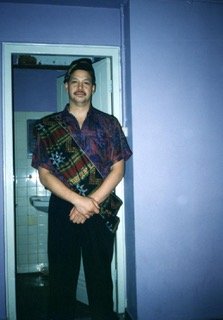Framing a Filipino-American Mestizo Identity (being but not feeling Filipino American), Part 2
By John Calloway
John opening for Tito Puente and Cal Tjader with Tipica Cienfuegos (June 1976).
My struggle with my Filipino identity began to take hold in my adolescent years, though I knew to a degree that in elementary school, I did not look like other Filipino-American children. While my in-home family activities still referenced some of the Filipino traditions, we were not led or actively encouraged by our parents to preserve language or cultural arts skills such as music and dance traditions. We did not regularly attend Filipino cultural events and celebrations. Middle school was the most difficult of times and going to a parochial school that was racially mixed with whites, Latinos and Filipinos, I was called every name in the book (and some they invented) about my mixed-race image: Kinky hair, light skin and slanty eyes. More difficult was transferring to public school for my last year of junior high, one that was fraught with anxiety as school gangs divided by race were common in the early 1970s. Not ever being raised in a consistent socio-cultural setting with other Filipino children and because of my mixed-race appearance, I felt most comfortable and was able to fit in with what I knew best, a racially mixed crowd of students. I was always leery, however, that Filipino students (both recent immigrants as well as second generation Fil-Am) would find out about my background and react in a negative way to my social choices and preferences.
During my high school years of the mid 1970s the social environment was more about cultural roots, identity and reclamation, a byproduct of the civil rights movement from the late 1960s. While ethnicity was a source of pride for other students, I was beginning to seriously struggle with my mixed-race identity, unsure that my cultural capital and appearance were enough for me to belong or feel a part of any ethnic or racial group. As I began to study music I found that and musicians, music classes and bands became my social network rather than with any ethnic or racial group, as pop bands tended to be integrated at that time. My growing love of Latin-based music such as Santana and salsa music had me drifting to socialize more with Latinos, who as a whole, were mestizos of all kinds as well as racially mixed. Such conditions allowed me to "blend" in with them without much question. The most hilarious thing that happened to me at Balboa High School in San Francisco was the time a Filipino student came up to me in a somewhat confrontational manner, and asked "Hey, you remember me?" I thought to myself, starting to get nervous, that I would have to fight him, that he found out I was mestizo and not hanging with other Filipino students. When I had really no response, he laughed and said "I'm your cousin!" It was Monty Dragon, brother of Bay Area Kali teacher Manuel Dragon.
“On the occasions that I ran into other Filipinos, I was frequently greeted with a certain amount of disbelief or confusion regarding explanation of my identity.”
As a young adult, the issue of identity and how others perceived me did not wane. Living in New York in the early 1980s to pursue a music career, I longed for some connection to my Bay Area familial roots. On the occasions that I ran into other Filipinos, I was frequently greeted with a certain amount of disbelief or confusion regarding explanation of my identity. Interestingly, like one of my musical idols, the Afro-Filipino Joe Bataan, I again easily blended into the Latino-Caribbean communities there and found solace and an acceptance in their communities. I even ran into other Latino musicians who also had some Filipino roots in their own ethnic makeup.
Upon my return to the Bay Area to continue my career in music and begin a second career in education, my identity issue still lingered. I had a great support system of family and cousins of Filipino ethnicity but I never brought up my struggle with them because I think they would have wondered why I would even question such a thing as my identity and heritage.
John Calloway is a multi-instrumentalist, composer and arranger who has over 40 years of experience as a professional musician. He has performed with renowned jazz artists Israel Cachao Lopez, Max Roach, and Omar Sosa. In the San Francisco Bay Area, John has built a solid foundation as a as a performer/arranger leading his own ensembles and projects as well as collaborations with John Santos, Marcus Shelby, Wayne Wallace and many others.
His recording credits as a performer and composer include his two CD projects, Diaspora and The Code, and longtime collaborations with John Santos, Jesus Diaz, and Omar Sosa. Included in his recording and writing credits are the Grammy nominations given to “SF Bay” (2003) with the Machete Ensemble, and Ritmo y Candela (1996) and Ritmo y Candela II (1998), produced by Greg Landau and featuring Cuban percussionists Changuito, Patato, and Orestes Vilato.
As an educator, John currently teaches jazz theory, Afro-Cuban and Latin American music in the School of Music at San Francisco State University. He also teaches social science and humanities courses with a concentration Latinx and Afro-Latinx cultures in the College of Ethnic Studies.
John holds a B.A. in music from the City University of New York, an M.A. in music education from San Francisco State University and a Doctorate in Education from the University of San Francisco.



